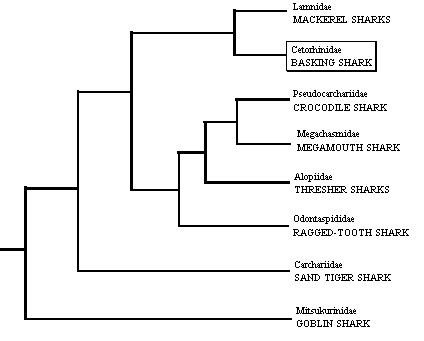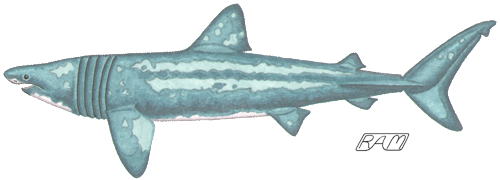Family Cetorhinidae:
Basking Shark — 1 species

- gill openings exceptionally large, almost meeting on top of the head
- teeth small, hooked (not blade-like), and numerous - over 150 rows in each jaw
- gill rakers elongate and bristle-like, formed from modified dermal denticles (seasonally shed in this filter-feeder)
- unusually long body cavity, housing an enormous oil-rich liver
- tail stalk slender with precaudal pits and strong lateral keels
- caudal fin nearly symmetrical, with lower lobe almost as long as the upper
- cool and warm temperate (rarely subtropical) zones of the Atlantic, Pacific, and Indian oceans

Basking Shark (Cetorhinus maximus)
Despite its tiny teeth and placid grazing habits, the enormous Basking Shark (Cetorhinus maximus) is clearly closely related to the large-toothed, actively predaceous mackerel sharks of the family Lamnidae - which includes the Great White and its closest relatives. Among living elasmobranchs, the combination of spindle-shaped body, large gill slits, slender tail stalk with strong lateral keels, and nearly symmetrical, crescent-shaped tail is highly unusual, being shared only by the Basking and lamnid sharks.
This commonality in structure strongly suggests that both the Basking and lamnid sharks inherited their unusual body form from a common ancestor. But the Basking Shark also possesses numerous specializations that the lamnids do not. Most of these specializations (reduced teeth, enlarged gill slits, and bristle-like gill rakers) are clearly related to the Basking Shark's filter-feeding mode of life. Plankton is often thinly distributed over large expanses of ocean, varying in abundance both seasonally and regionally. One would therefore expect that - for a fish - efficient swimming ability would be a firm prerequisite for a career in filter-feeding. From these facts, it seems likely that the characteristic body form of Basking Sharks evolved before they diverged from their common ancestor with the lamnids. Based on morphological evidence, shark systematist Leonard Compagno (1990) proposed that the Basking Shark is the primitive sister taxon to the lamnids. This interpretation is fully supported by mtDNA sequence data and is shared by Naylor et al. (1997). However, the fossil record of Basking Sharks can be traced back only about 35 to 29 million years (compared with 65 to 60 million years for the earliest lamnid, Isurolamna inflata), represented by the bristle-like gill rakers and hook-like teeth of an extinct species known as Cetorhinus parvus. The fossil record of Basking Sharks may well extend father back, but its brittle gill rakers often break into barely-recognizable fragments and its tiny teeth are easy to overlook.
It has been suggested that there may be as many as four species of Basking Shark: two from the North Atlantic and Mediterranean (C. maximus and C. rostratus), one from southern Australia (C. maccoyi), and one from the South Atlantic (C. normani). In their 1976 review of Basking Shark systematics, ichthyologists Stewart Springer and Perry W. Gilbert suggested that most of the differences between the various species noted by E. Siccardi (1961) may be due to allometry (changes in relative proportions associated with growth). Springer and Gilbert concluded that there is insufficient evidence at present to separate these species. Compagno (1984) concurred provisionally with Springer and Gilbert, pending further evidence. Perhaps one or more geneticists will eventually obtain tissue samples from each of these purported Cetorhinus species and secure adequate funding to properly investigate the matter.
- More about the life history and behavior of the Basking Shark
